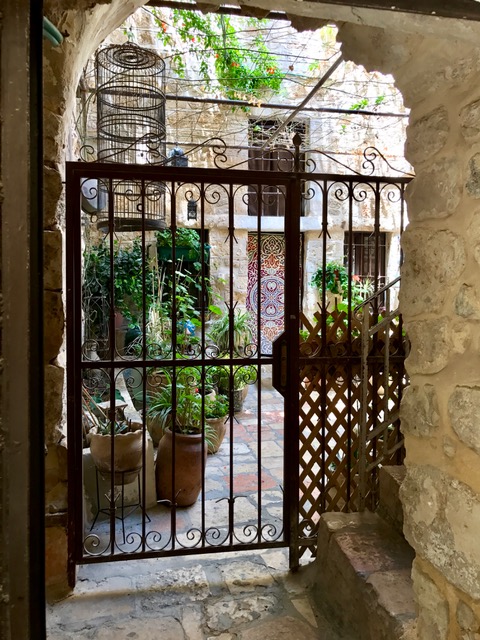Dear Blog Friends
Moe and I left Israel on Saturday May 20th (separately); Moe for home and myself for Ireland. However I hope to continue blogging, so stay tuned. Weather-wise, I can say three weeks in Israel without rain!
Thank you to Fodor's Israel Tour Book!
We Visit the Four Quarters of the Old City on a Free Tour (plus tip!) Here's an overview (literally) and a street view. I am combining photos from that tour, plus from a walk upon the city walls plus a visit to the Temple Mount.
Jerusalem is Holy Ground
Unforgotten and unforgettable, Jerusalem is holy ground for the three great monotheistic religions, whose numbers embrace half the world's population. It's Old City is home to some of the most sacred sites of Judaism, Christianity and Islam. Millions of people come to the Old City each year, as pilgrims, as tourists, as archaeologists, as historians, as Bazaar shoppers or whatever. Some come to feel whole, or seek their soul, or to have a sense of communion with ancient epochs. Faith, history and culture commingle here as in no other place. Portions by Mike Rogoff
Four Quarters in the Old City
Jewish, Armenian, Christian & Muslim.
Gates to access the city are numbered.
Jewish Quarter
The Jewish Quarter is very different in appearance from the others, sporting modern buildings and open spaces. It is at once the Old City's oldest quarter and its newest neighborhood. During Israel's War of Independence the Jewish Quarter surrendered to Jordanian forces and was abandoned. During the 1967 Six-Days' War the Jewish Quarter, much of it ruined, was recaptured. Rebuilding began - apartments, educational institutions, synagogues, stores, restaurants.
This is not rubble; it is an ancient wall. The perfect time for archaeologists to explore the layers under the Jewish Quarter was after it was ruined and before it was rebuilt. There are archaeological ruins under all of the Old City that haven't been tapped.
Large open areas for children to play
The population of the Jewish Quarter is almost entirely religious, split between "modern" Orthodox Jews and ultra-Orthodox (men in black frock coats and black hats). Women tend to dress modestly and families are big. The Israeli army maintains an educational center in the Jewish Quarter. Large groups of Israeli soldiers, often kidding around, can be seen following their guides on tours around the Old City.
View from the Jewish quarter across the Western Wall Plaza towards the Western Wall (center).
The wooden walkway on the right winds up to the top of the Temple Mount & the Dome of the Rock (left) and the Al-Aqsa Mosque (right, the long grey building between two groups of trees, with a small gray dome). We went up to the Temple Mount on another day.
The Western Wall was not part of the Second Temple, but part of the 2,000 year-old retaining wall that King Herold built to create the huge "shoe-box" upon which the Second Temple stood.
Our free tour guide explains
Ofer, our OAT (Overseas Adventure Travel) guide took us to the Western Wall on Friday night, the beginning of Shabbat, to experience the emotionality and spirituality of the place and people. So we of several faith traditions or of no faith tradition touched the Wall and perhaps tucked a prayer into a crack of the stone.
We went up on the Temple Mount on a different day. Following are a few of my pictures. See Moe's post as "Unknown" for pictures of that adventure.
Security is strict at the Western Wall and at the Temple Mount, understandably.
Wooden walkway to access the Temple Mount. From here you an look down on the Western Wall for some great photos.
Women and men pray separately in their own sections at the Western Wall, but there seems to be some "peeking" and "distracting" going on!
Bar Mitzvah boy reading the Torah. Many families come to the Western Wall to celebrate their sons' Bar Mitzvah.
Christian Quarter
Fragmented into a dozen denominational domains, The Christian Quarter is capped by the large gray dome of the Church of the Holy Sepulcher. The numerous churches and religious institutions in this quarter make for low population density. The famous Via Dolorosa (Way of the Cross) begins in the Muslim Quarter and winds its way to the Holy Sepulcher.
Detail of the Holy Sepulchre
Entrance to the Holy Sepulchre
Different Christian entities fought over who should unlock the Holy Sepulchre every day and lock it every night. Finally a Muslim family was asked to undertake the job and descendants of that family carry on today.
Entrance to the Muristan, a complex of streets and shops in the Christian Quarter
Businesses are in the Quarter
The Latin Patriarchate of Jerusalem. The archdiocese of Jerusalem has jurisdiction over all 'Latin Church' Roman Catholics in the Holy land. The community in Jerusalem is some 4,500 people out of an estimated Christian population of 11,000 - making it the largest community in the Christian Quarter.
A Nun's work is never done
The Latin Patriarchate
The Custody of the Holy Land is a custodian priory of the Franciscan order in Jerusalem. Terra Sancta is latin for 'Holy Land'
The Muslim Quarter
The Muslim Quarter is by far the largest and most populated quarter. Numerous side street, grocery stores, neighborhood mosques and stenciled pictures of Mecca characterize this residential area.
Most of the photos of the markets in the Old City, posted previously, are from the Muslim Quarter.
All of the following photos were taken from above, from the top of the Old City wall. Certain areas of the wall are open to tourists and give a fabulous view of the sights.
We walked the walls from the Jaffa Gate past the New Gate to the Damascus Gate on a different day from the Quarters Tour.
Muslim school or day care
Just inside the northwestern corner of the Old City, an area surrounded by the Christian Quarter, is a modest family mosque, known a Masjid al-Qaymariyya.
Wall of Masjid al-Qaymariyya mosque is on the left
The small Masjid al-Qaymariyya mosque has a large dome!
This German Shepard mix was very vocal and fierce-looking until you talked to him...
Above the Damascus Gate
Looking out across the Muslim Quarter (L) and the Christian Quarter (R)
Armenian Quarter
The Armenian presence in Jerusalem dates back to the fourth century AD when Armenia adopted Christianity as a national religion and Armenian monks settled in Jerusalem The Armenian community has been in decline since the mid-20th century
.
There is a birds-nest of electrical wires throughout most parts of the Old City
Armenians are known for their beautiful tiles. This is above a doorway
Armenians believe that this is the site of the Last Supper
Life in the Old City
Tons of tourists, hap-hazard electrical lines, parking problems, long walks to and from parking - what's not to like! There are schools for children,and I'm sure hidden away, there are some doctor's offices and other services. Some residents experience a spiritual wholeness living in the Old City. I think it would teach me patience...
Borders between quarters may be problematic for adults, but kids seem to move around freely.
Could be there to keep pigeons from roosting... or to keep young children from climbing and falling...
How you drive a car in the Old City is a mystery, let along park it!
Temple Mount
The Temple Mount is holy to both Muslims and Jews, and to Christians as well. It is revered by Jews as the place where god gathered together the dust to create Adam and where Abraham almost sacrificed his son Isaac. In about 1000 BC King Solomon built the First Temple there. That structure was destroyed by the Babylonians and the Second Temple was built.
In order to build the Second Temple on a grade scale, Herold leveled of the top of Mt. Moriah. Massive retaining walls, including some of the largest building stone known, formed a huge shoebox-like structure which was filled in to make the Temple Mount.Upon it was build the Second Temple, the one Jesus knew, as an architectural wonder of its day.
In 70 AD the Romans reduced the building to smoldering ruins and many of it treasures were carried off as booty.
The inner sanctuary of the temple, which housed the Ark of the Covenant, was called the Holy of Holies, a place where only the high priest was allowed to set foot. Since nobody knows exactly where the sanctuary stood, religious Jews are forbidden even today from entering the Temple Mount. They pray instead at the Western Wall, a remnant of the Second Temple's outer courtyard.
Muslims identify the foundation stone as "the farthermost place," from which Muhammad rose to heaven, and call this area Haram esh-Sharif, the Noble Sanctuary. The Quran says that the Prophet took a miraculous night journey to Jerusalem on a winged horse. before ascended to heaven to received from Allah many of the main tenets of Islam.
Muhammad's Night Journey
Nasser D Khalili collection
After the Muslim conquest of Jerusalem in 637, the Umayyad caliphs built the Al-Aqsa Mosque and the Dome of the Rock - Jerusalem's most recognizable monument - on the site.
Temple Mount fountain for ritual purification
Awnings provide necessary shelter during hot days
So who governs the Temple Mount? Muslims have controlled access to the site since 1187 when Arabs took back Jerusalem from the Crusaders. An Islamic Trust administered the site and Jews were not allowed to enter. After the Six-Day's War in 1967, The Temple Mount area became part of occupied Israeli territory. Moshe Dayan, the defense minister st the time met with Muslim Leads and reached an agreement. The trust would continue to administer the Noble Sanctuary, but Jew would be allowed to enter the site as tourist, but could not pray there.
Well, how's that working out? Not so good... it has been the source of great frictions.









































































